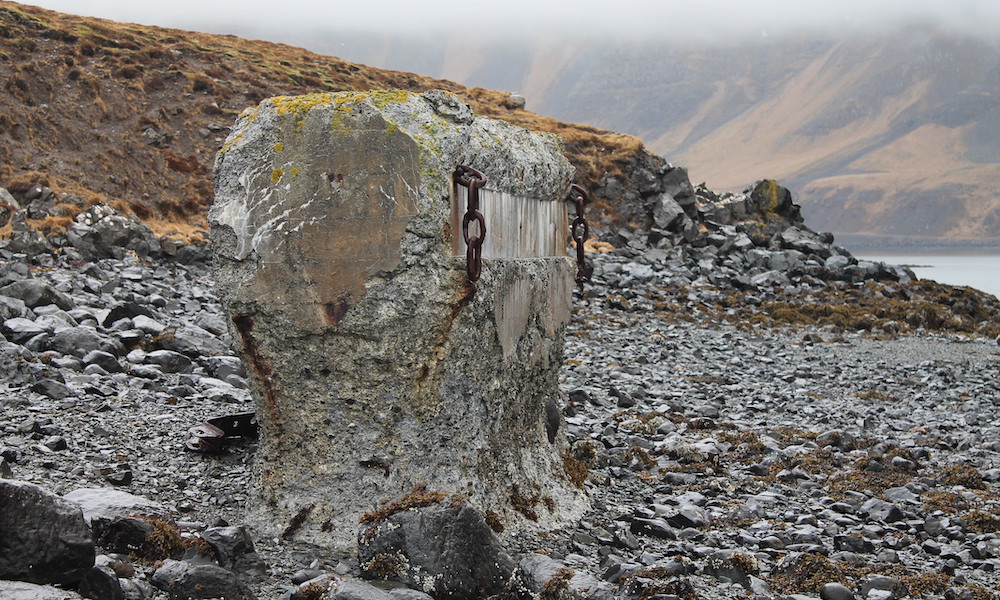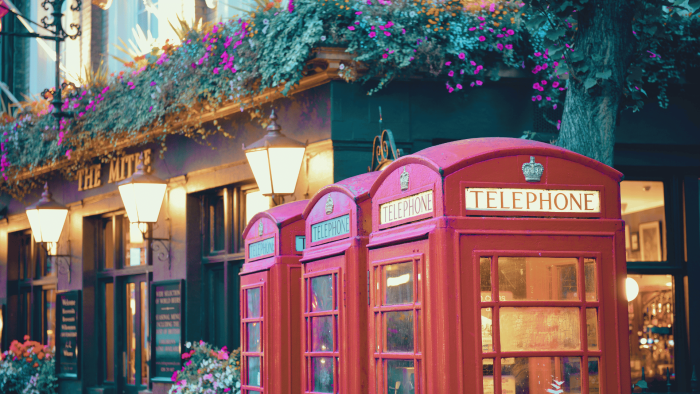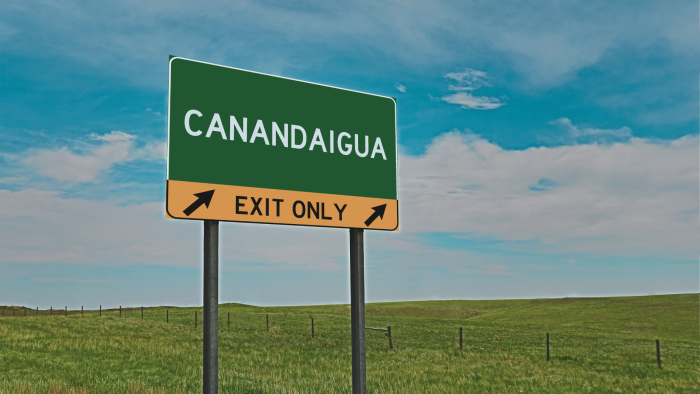My dad’s been pushing for a family Iceland trip for years. I’ve been resistant, not because I’m averse to all things Nordic, but because Iceland was one of the epicenters of the massive upheaval that came from cheap airfare, when suburban white millennials were discovering the power of words cultured and worldly. The travel industry publication Skift labeled it as the “poster child for the positive and negative effects of the overtourism phenomenon.”
Yet I was finally in support of the trip this year because I’ve been seeing a hell of a lot of pictures of Machu Picchu from influencers and pseudo-influencers rather than black sand beaches. I figured Iceland would finally have a bit of breathing room. I don’t know if I’m right since 2022 tourism numbers were bumping back up to pre-pandemic levels. That said, June 2022 was only the fifth strongest June since the tourism boom, showing that maybe tourism is falling to a more sensible, sustainable level. Whatever the numbers show, my experience wasn’t the mad crush I was expecting.
I’m glad I held off, because one of our stops on this family vacation was one of those close-your-eyes-while-you-book places: Hvammsvík Hot Springs—it opened last year and wouldn’t have been on the earlier itineraries. It’s an estate and nature preserve with vacation accommodations and hot springs located on Hvammsvík peninsula in Hvalfjörður, a fjord not far from Reykjavik. Hvammsvik Hot Springs’s site talks a lot about living in balance with nature, which is great and admirable and definitely one of my priorities. But I’ll admit the reason I was dead set on the place was that the beaches on the peninsula frequently had artifacts from the Second World War wash up among the rocks and sand.
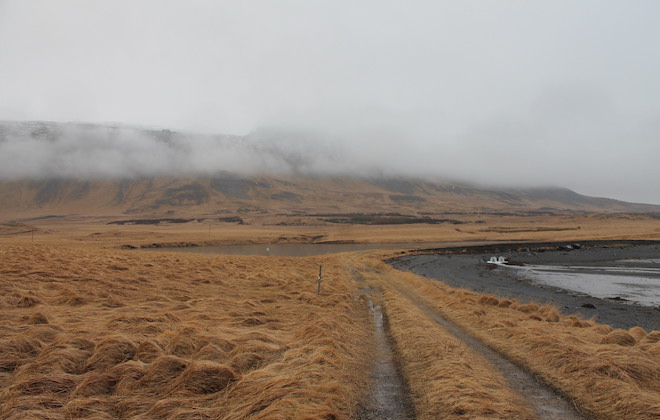
Most of everything we found was down on the beach on the right.
Hvalfjörður During World War II
The Second World War hit Iceland quickly, though the ramifications were more political than they were violent. In 1940, Iceland was Danish territory, similar to Greenland’s current status, but when Germany invaded and occupied Denmark on April 9, 1940, Iceland was cut off from Danish rule. The Icelandic people moved quickly and elected a provisional governor, Sveinn Björnsson. It could almost be understood as involuntary sovereignty, a unique path to independence from continental influence.
Not that it lasted long. The British invaded and occupied Iceland on May 10, 1940 and brought in Canadian troops not long after. Icelanders weren’t happy about it at the beginning, as most people aren’t when the British invade. The difference between Iceland and most of the other places the British end up is that they were able to come to a peaceful agreement with the people of Iceland and turned Hvalfjörður into an Allied supply hub and Reykjavik into a bustling metropolis. It was an arrangement that held when American forces took the fjord over from the British in July 1941.
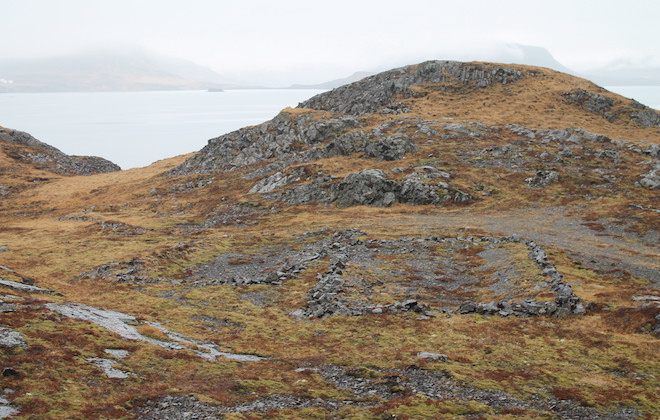
I was standing on the concrete pad and thought it odd I couldn’t see other ruins. Then I realized I wasn’t looking close enough.
Both militaries built up the fjord to fit their needs, which meant piers, barracks, huts, tents, paved roads, recreational facilities, and storage, plenty of which can still be visited and some of which are still in use. It was a massive investment in Icelandic infrastructure that otherwise wouldn’t have happened and set the country up for the 20th century.
The place we were staying, Hvammsvík, and the island across from the hot springs, Hvammsey Island, were recreational facilities for US naval troops. Hvammsvík peninsula also served as a storage facility for ammunition and deep sea bombs and a British naval officer lived at the highest point of the peninsula, Hvammur Hill, to better oversee operations in the fjord. The officer’s house is still there and one of the properties the hot springs rents out to tourists.

Another Hvammsey ruin. The pad was roughly 10 by 15 feet and surrounded by old cinder blocks.
There’s a hell of a lot more to say about Iceland, Hvalfjörður, and Hvammsvik during World War II, but let’s put a button on it by saying where I was staying was right in the midst of one of the major supply depots for the war. Uses like that don’t tend to fade to simple stories just because a government reclaims and repairs the land where it took place.
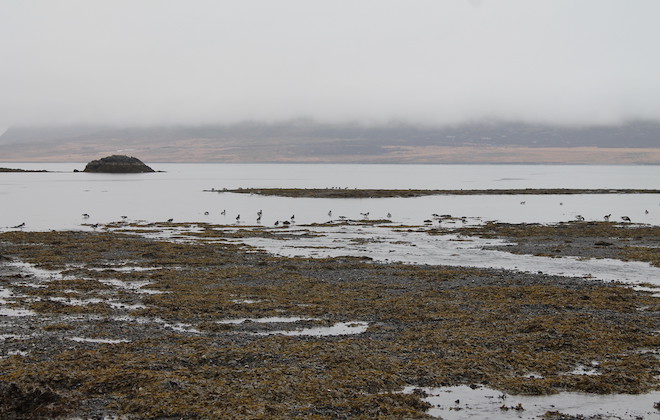
The beach where we found most of the pieces of sea glass and ceramics, all under the watchful eyes of Icelandic sea birds.
Combing the Hvammsvík Beaches
The optimist in me took my expectations and sprinted away with them. For the weeks leading up to my trip, I had visions of myself strolling along a black sand beach, the gentle surf sweeping antique shell casings, war medals, helmets, gun parts, belt buckles, and a dozen other amorphous bits of war memorabilia right at my feet. There was also an historian and an archaeologist following along behind me in those visions, delivering poignant insights about whatever artifact materialized in my hand. This is obviously not how my search went.
My main reality check was the realization a few days before that I had little to no chance of finding spent ammunition, parts of firearms, and the flotsam that falls out of a combat troop’s pocket or off his uniform. Hvalfjörður was a supply depot, not a combat zone, and any fragments I was going to find would reflect that. In and of itself, that’s not a disappointing realization. A historical relic is a historical relic. Their value is self-evident and I’d be happy to collect whatever was on the beach.
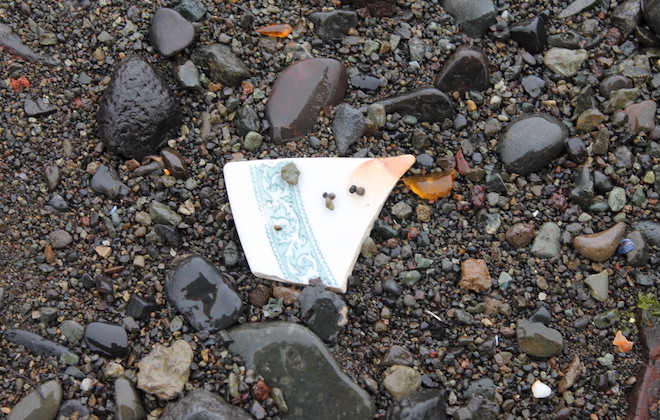
Most of what we found were simple white shards, so finding something with some decoration was a happy accident.
In my time on the peninsula, I was able to comb two sections of beach. The first was the northern beach on the first day I was there. That day served as a proof-of-concept to see if reality mapped even a little bit on the optimistic image my brain had conjured up. The good news is, it did, though, again, not with spent shell casings and rusty guns. Instead, we found scattered bits of ceramics and rusty springs and rods. And we found them fast.
I got my first piece, a large sliver of what looked like a soup or cereal bowl, pretty much as soon as I walked on the beach. The search was helped by the fact that most of the ceramics are white and the beach is made of dark volcanic rock. The ceramics also reflect light differently than the surrounding rocks. There’s a bit of diffusion below the surface of the ceramic, and the matte finish contrasts the shinier rocks. Those were the main discoveries of the first day: bright white pieces of worn ceramic among black rock. Most of them were fairly featureless, just simple white pieces broken in random shapes with the edges worn smooth by eight decades bouncing around the bottom of a fjord.

The main way out to Hvammsey Island (as seen here from Hvammsvik Peninsula), besides being an Allied soldier, is to cross a land bridge at low tide.
Admittedly, I was initially a little disappointed in only finding ceramics. Like I said, they’re not exactly the thing you think of when you’re looking for World War II memorabilia. Plus, what if Icelandic teenagers like chucking their mom’s china into the fjord? We might not even be finding stuff from the Second World War, we might be finding the shards of Nordic angst.
The disappointment didn’t last long. I reviewed the information packet in the house we were staying in and a few online resources, all of which specifically call out ceramics as the main pieces that wash up on the beach. My resolve to search even longer the next day returned.
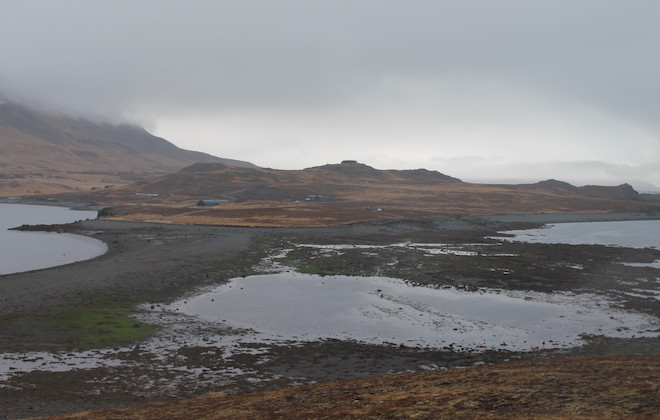
Hvammsvik peninsula as seen from the top of one of the hills on Hvammsey
On our second day, we stuck to a small inlet on the northwestern side of the peninsula and made sure to start our search with the tide well on its way out. We were immediately surprised at the sizable increase in the number of pieces we found, along with their variety. The ceramics on the inlet beach had designs along their edges, including simple blue lines, stylized laurels, and manufacture location markings. One tiny piece even had what looked like the outlines of two blue sailboats.
Not only were we finding plenty of pieces of ceramics, but the ceramics were far outnumbered by pieces of sea glass. There were places on the beach where it felt like we were stepping on more glass than we were stone or sand and some boulders had huge gatherings of glass sheltering behind them. Most pieces were green, brown, or translucent white and were clearly pieces of shattered bottles, but a few had the wired reinforcements that suggested they may once have been the windows of the Allied buildings in the fjord.
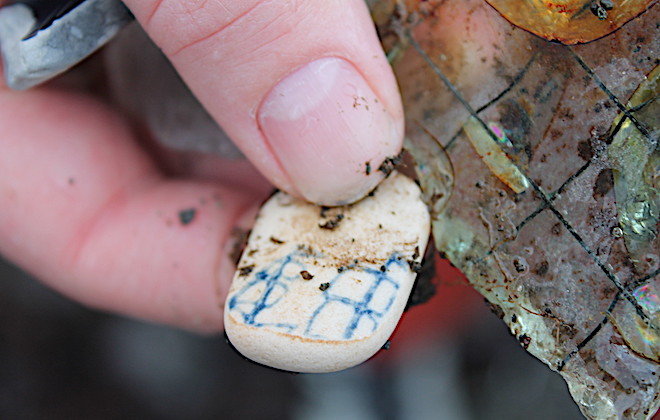
Probably the most intricate detail we found on any piece. Use the thumb as a reference point to see how small these decorative sailboats were.
That same day, we got ourselves across a tidal land bridge to Hvammsey Island, which housed the U.S. rec centers. It’s a small island with two hills: one small one on the northern side and a slightly taller series of jagged peaks on the southern. There isn’t much evidence of the U.S. presence left on the island save for a few loose stone enclosures, a couple poured concrete pads, and a collapsed cinderblock wall. The most notable ruin I saw was a section of concrete sea wall or dock (I’m not sure which) that stood on the beach that faced the hot springs. None of it was much, but I still thought it was enough to ground me in the history of where I was standing.
My other more sobering but more valuable reality check was that I’ll likely never know the story behind our finds. Instead, we have to rely on the kind of circumstantial history that fuels the sentimentality behind a lot of people’s keepsakes. By that I mean, we might not ever know the true origin of our artifacts, but we know we found them on the beach in a sparsely populated fjord next to the ruins of Allied supply depots and rec centers, the artifacts aesthetically line up with the Second World War time period, and soldiers and sailors are notorious for their littering. Not being a historian, I don’t need to present exhaustive cataloging of my random bits of glass and ceramic. Circumstantial evidence is more than enough to keep me happy.

